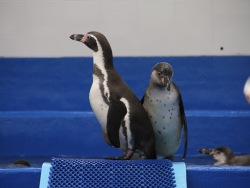Our New Penguins Found Pacific Smelts and Capelins Delicious

Recall that six Humboldt penguin babies have recently arrived to Primorsky Aquarium from Czech Republic.
In the Czech hatchery, penguins mainly fed on sprat (Baltic herring). The Primorsky Aquarium's specialists have developed a diet for them consisting of local fish species.
"At first, our little birds were offered capelin to eat that is believed to contain a lot more nutrients than the sprat," ornithologist Vladislava Kreshchenovskaya tells. "We feared that the penguins would refuse food; it could happen due to stress caused by long flight and change of their locality generally. To our pleasure, it did not happen – our birds began taking food immediately. Right after arrival, birds had four meals a day to get their daily ration. Then the smelt was added to the capelin in the menu. Interestingly, the penguins took the smelts but treated them with caution leaving fish in the water and after examining ate up the fishes the very night."
The baby birds have liked their "Pacific" diet. They each have 600-800 g of fish a day, feeding thrice daily on smelts and capelins in equal proportion with including necessary vitamins; they get whole fishes without cutting. A short time late, ivaci (Pacific sardine) is going to vary the penguins' menu.
During initial few days, baby birds were fed in the water but feeding procedure kept changing: they swam up to a board to get food first, then got on the bridge, and then went down on land following the ornithologists beckoning them. Currently, when the penguins and their "bird-kindergarten teachers" get in good contact, feeding occurs on the land only.
"In the beginning, penguins fought, pushed off one another," Ksenia Lyubimkina, ornithologists tells. "One grasped a fish and ran to the water and all others rushed after it trying to take the food away. We however were patiently waiting for them by the board with full buckets… Now they behave sedately – come out on the land and take the fish by turns. Curiously, the female birds (there are three of six) eat more orderly and tidy than male ones. All the penguins are hand-fed to make sure each of them gets its ration. We always leave fish portions for two shy male-birds, which usually stand aback and approach the bucket after all the others."
The penguins have already known the feeding time and about five minute before it, they are waiting on the bridge looking attentively at the entry door or gathering by the tank edge. Having been full, they relax drifting sidelong.
For information:
- Penguins (Spheniscidae family) are a group of aquatic, flightless birds. Like other birds, they have wings evolved into flippers and are covered with feathers. They lay eggs and are warm-blooded animals, and highly adapted for life in the water.
- There are 17 different species of penguins, and they vary in size and shape. The emperor penguin is the largest of all living penguins being about 1.1 m tall and weighing 35 kg, on average. The smallest of the penguins is the little blue penguin, standing just 40 cm and weighing about 1 kg. All species of penguins live in the Southern Hemisphere with only one species, the Galapagos penguin, found north of the equator.
10/03/2018
